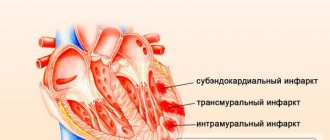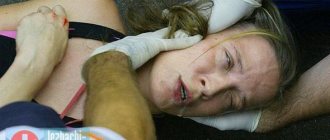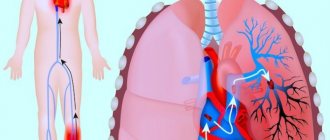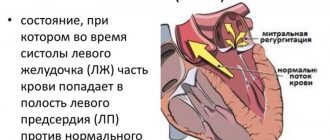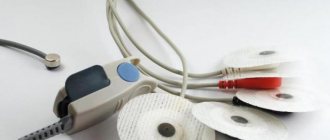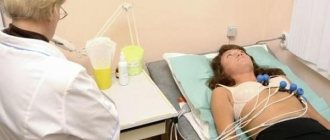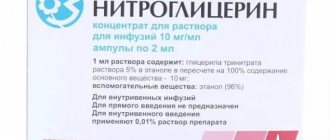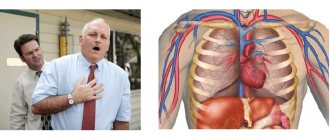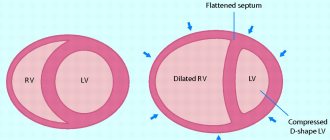Causes of coronary insufficiency
Coronary insufficiency can occur as a result of two reasons that lead to disruption of the normal movement of blood through the arteries:
- The tone of the arteries changes.
- The lumen of the arteries decreases.
Changes in arterial tone
Spasm of the vascular wall and decreased arterial tone may be a consequence of increased release of adrenaline. For example, under severe stress, which many describe with the phrase “the heart sank in the chest,” there is a temporary lack of oxygen. It is easily compensated by an increased heart rate. As a result, blood flow increases, the flow of oxygen increases significantly, and a person’s mood and well-being may even improve temporarily.
There is nothing terrible in a short-term stressful situation. On the contrary, it can be considered as a training to reduce the sensitivity of the coronary vessels to spasm (prevention of coronary heart disease).
However, if the stress is prolonged, a decompensation phase begins. This means that muscle tissue cells use up all their energy reserves. The heart begins to beat slower, carbon dioxide levels rise, and arterial tone decreases. Blood flow in the coronary arteries also slows down.
As a result, metabolism in the heart muscle is disrupted. Some parts of it may even become dead (necrosis). The resulting necrotic lesions are known by the common name "".
Decrease in arterial lumen
The lumen of the coronary arteries decreases due to disruption of the normal state of their inner lining or due to blockage of blood flow by a formed thrombus (atherosclerotic plaque, blood clot). The following factors contribute to the occurrence of pathology:
- smoking (due to the intoxicating effects of tobacco smoke on the body, the cells of the inner layer of the arteries change, and the risk of increased thrombosis increases);
- eating large amounts of fatty foods (fraught with a lack of proteins, changes in the balance of microelements and vitamins, disruption of metabolic processes);
- stress (due to increased adrenaline levels, prolonged arterial spasm occurs);
- low physical activity (leads to venous stagnation, deterioration of oxygen supply to tissues, and decreased strength of heart contractions).
Reasons for development
Acute coronary syndrome (ACS) is another name for this pathology. It mainly begins as a result of atherosclerotic vascular damage.
The pathogenesis (mechanism of development) of this disease is the deposition of cholesterol in the walls of the arteries, due to which they lose their elasticity and blood flow is impeded. The disease code according to ICD-10 is 124.8.
When the blood supply to the myocardium is partially disrupted, a lack of oxygen occurs and the cells do not receive enough substances necessary for life. This condition is called coronary heart disease. When blood flow is completely blocked, a heart attack develops.
Reasons why ACS may occur:
- thrombotic stenosis;
- dissection of arterial walls;
- vasospasm;
- fibrosis;
- the presence of a foreign body (embolus) in the blood supply;
- inflammation of the serous membrane of the heart (endocarditis);
- narrowing of the lumen of blood vessels.
Impaired blood supply to the myocardium is also possible due to injuries in the heart area (for example, a knife wound) or previous surgical operations.
People with the following diseases are at increased risk of developing ACS:
- ischemia, previous heart attacks;
- myocardial dystrophy and myocarditis (inflammation of the muscle tissue of the heart);
- tachycardia;
- diabetes;
- hypertension;
- congenital tendency to sudden cardiac arrest;
- pathologies of the vascular system (thrombophlebitis, thromboembolism).
The following conditions are also risk factors:
- obesity, unhealthy diet (leading to cholesterol accumulation);
- smoking, taking cocaine;
- low physical activity;
- old age (the risk of ACS increases after 45 in men, 55 in women).
Symptoms of chronic coronary insufficiency
Symptoms of the disease do not always appear: in some cases, the development of pathology takes a long time. One of the key signs is angina, but it may take some time for it to develop. At first, the patient may periodically feel interruptions in the functioning of his heart. The rhythm will be disrupted, causing tachycardia or arrhythmia. But more often angina begins to develop in three stages:
- Disturbance and occurrence of chest pain at times of increased activity or stress.
- Pain and symptoms increase with normal exercise. Studies show major changes in the coronary blood flow system.
- A particularly aggressive and severe form in which symptoms occur at rest. A rhythm disturbance is added, and the pain in the sternum intensifies to the maximum.
As the condition progresses, symptoms of coronary insufficiency increase:
- heart rate increases;
- suffocation, pain in the heart and behind the sternum are felt;
- severe shortness of breath appears even at rest.
The pain can radiate to the left arm and ear. Most often it occurs suddenly, the attack lasts from 2 to 22 minutes. The symptoms are acute, the patient characterizes his condition as follows: “I felt a sharp pain behind the sternum, I couldn’t breathe.” In chronic forms, such attacks can become periodic, especially aggressively occurring at night. The situation may become critical if the peak of the attack lasts more than 20 minutes. In such cases, conditions are created for the development of extensive myocardial infarction.
Without treatment and intervention from specialists, the situation will only get worse. As the disease progresses, the lumens of the vessels become increasingly narrowed. The heart receives few vital components, the blood flow supplies less and less oxygen. The symptoms will become more aggressive, the dynamics will completely reach a negative value.
First signs and symptoms
In approximately half of cases of coronary insufficiency, no symptoms appear. The person feels slightly dizzy and has an accelerated heartbeat. In other cases, signs of pathology appear in a complex.
Symptoms of acute coronary artery disease before death include:
- pressing or painful, often burning sensations in the sternum;
- pain is projected to other parts of the body (abdomen, shoulder blades, arms, etc.);
- profuse sweat;
- convulsions;
- foaming from the mouth;
- the appearance of shortness of breath;
- nausea, sometimes with vomiting;
- slow breathing, shortness of breath;
- sudden pallor;
- severe dizziness, sometimes with loss of consciousness;
- causeless weakness.
Pathology rarely occurs in people who do not have any cardiovascular diseases.
A person who has frequent angina attacks may confuse its symptoms with ACS. However, there are some differences. With a normal heart disorder, pain lasts 5-10 minutes, and with coronary syndrome, it lasts longer - up to 6 hours.
Angina pectoris is characterized by discomfort and tightness in the chest. Pain during ACS can be so severe that it blocks any movement.
Causes of coronary circulatory disorders
When asked why there are interruptions in the supply of myocardial tissue with blood and nutrients, experts usually answer that coronary insufficiency occurs as a result of primary or secondary disorders.
- Primary. They occur directly in the vessels due to injury, inflammation, the formation of lipoprotein and calcified plaques, and blood clots.
- Secondary. They are provoked by accelerated metabolism in the myocardium, caused by damage to the structure of the coronaries. Similar changes occur throughout the vascular network.
Problems with the coronary vessels that affect blood flow are conventionally divided into congenital and acquired. Congenital malformations appear in the fetus when it is still in the womb and are not susceptible to external influence. It happens that there is a genetic predisposition to common diseases that ultimately lead to vascular damage (very often this is diabetes mellitus, which is inherited). Acquired pathologies arise due to stress, working in hazardous industries, living in an environmentally unfavorable region, eating fatty foods, and lack or excess of physical activity.
The triggering mechanism for insufficiency of coronary blood supply is the following:
- IHD or ischemia caused by the heart's acute need for oxygen during sports, during stress, in case of alcohol addiction;
- disruption or complete cessation of the electrical system of the heart muscle (asystole);
- a sharp drop in blood pressure and worsening coronary circulation during sleep;
- anemia;
- atherosclerosis - the formation of cholesterol deposits on the vascular walls;
- coronary sclerosis - the term refers to the entry of detached cholesterol plaques directly into the coronary arteries;
- atrial fibrillation (ventricular fibrillation);
- spasm of coronary vessels - possible due to intoxication with harmful gases, inhalation of cocaine;
- arterial damage - inflammation, stenosis, ruptures;
- damage to the heart muscle - due to a knife wound, the appearance of post-infarction scars on the myocardium;
- thrombophlebitis - it usually develops in the lower extremities, while blood clots formed in the veins can block the lumen of the coronary artery;
- heart defect – often it is a congenital defect of large vessels;
- diabetes mellitus – the presence of sugar in the blood promotes the growth of blood clots;
- obesity – it provokes diabetes mellitus, increases cholesterol levels in the blood, and also thickens it, stimulating blood clots;
- anaphylactic shock - during an allergic reaction, cells produce histamine, which slows down peripheral and central blood circulation.
General information
Coronary insufficiency is a pathological condition that develops as a result of a partial or complete cessation of blood flow through the coronary arteries, which ultimately leads to inadequate provision of cardiomyocytes with oxygen and nutrients. , coronary heart disease develops . With coronary insufficiency, a local zone myocardial ischemia hypoxia is observed with severe anemia , respiratory failure, pathological structure of hemoglobin and other non-vascular factors.
Treatment tactics
The patient can be saved only with emergency diagnosis and medical care . The person is placed on a hard base on the floor, and the carotid artery is checked. When cardiac arrest is detected, artificial respiration and cardiac massage are performed. Resuscitation begins with a single blow to the middle zone of the sternum with a fist.
The remaining activities are as follows:
- immediate implementation of closed cardiac massage – 80/90 compressions per minute;
- artificial ventilation. Any available method is used. Airway patency is ensured. Manipulations are not interrupted for more than 30 seconds. Tracheal intubation is possible.
- defibrillation is provided: start - 200 J, if there is no result - 300 J, if there is no result - 360 J. Defibrillation is a procedure that is implemented using special equipment. The doctor applies an electrical impulse to the chest to restore heart rhythm;
- A catheter is inserted into the central veins. Adrenaline is given - 1 mg every three minutes, lidocaine 1.5 mg/kg. If there is no result, repeated administration is indicated in an identical dosage every 3 minutes;
- if there is no result, ornid 5 mg/kg is administered;
- if there is no result – novocainamide – up to 17 mg/kg;
- if there is no result - magnesium sulfate - 2 g.
- in case of asystole, emergency administration of atropine 1 g/kg every 3 minutes is indicated. The doctor eliminates the cause of asystole - acidosis, hypoxia, etc.
The patient must be hospitalized immediately. If the patient has regained consciousness, therapy is aimed at preventing relapse. The criterion for the effectiveness of treatment is the constriction of the pupils and the development of a normal reaction to light.
During cardiopulmonary resuscitation, all drugs are administered quickly, intravenously. When there is no access to a vein, Lidocaine, Adrenaline, Atropine are injected into the trachea, increasing the dosage by 1.5-3 times. A special membrane or tube must be installed on the trachea. The drugs are dissolved in 10 ml of isotonic NaCl solution.
If it is impossible to use any of the presented methods of drug administration,
the physician decides to carry out intracardiac injections .
The resuscitator uses a thin needle, strictly observing the technique. Treatment is stopped if within half an hour there are no signs of the effectiveness of resuscitation measures, the patient does not respond to medication, and persistent asystole with multiple episodes is detected. Resuscitation does not begin when more than half an hour has passed since the blood circulation stopped or if the patient has documented a refusal to take measures.
First aid for an attack of coronary heart failure
The pain that occurs during an attack cannot be tolerated, so the spasm must be stopped as soon as possible. It is important to try to establish normal blood circulation.
At the first symptoms of an incipient attack of coronary heart failure or detection of its syndrome in a neighbor, it is necessary to call an ambulance and take urgent action. It is better to endure a crisis during coronary insufficiency while sitting, leaning against the back of a chair or sofa.
Emergency care for acute coronary syndrome:
- At the first signs of the syndrome, you should calm down and stop activity. In a calm state, the load on the heart muscle is reduced and normal circulation is gradually restored.
- In parallel with the cessation of activity, you need to take first aid medications - Validol or Nitroglycerin.
In acute coronary syndrome, emergency physicians must give the patient medications to relieve pain (often narcotic medications) and aspirin with clopidogrel to thin the blood. If the seizure is not controlled by medications, the patient is taken to the hospital, where, on the recommendation of a doctor, surgery may be prescribed.
Without proper treatment, sudden death can occur after attacks of acute coronary insufficiency. Timely first aid and going to the hospital play a very important role. Studies show that the death rate from coronary insufficiency outside the walls of the hospital is almost twice as high as the death rate from a heart attack within the walls of this institution.
As a rule, the emergency team carries out resuscitation efforts together. But what to do if a person is unconscious and the ambulance has not arrived yet?
It is important to know the basic resuscitation techniques that can be provided to a victim during a severe attack of acute coronary insufficiency.
Before proceeding, it is necessary to determine whether the patient is conscious and breathing on his own. Be sure to check for a pulse. If the victim does not answer the simplest questions, what is his name and where he is, you can lightly pat him on the cheeks. If there is no reaction, it means the person is unconscious.
How does cardiopulmonary resuscitation occur:
- Stage 1 – you need to ensure airway patency. The victim should be placed on a flat surface, his head tilted slightly back, holding him with one hand. With your other hand, press on your chin, opening your jaw. After this, wrap your fingers in a bandage or clean cloth and empty your mouth of accumulated saliva or other liquids (blood, vomit, water). If breathing appears, great, wait until the patient regains consciousness. If there are no changes, you need to move on to the second stage.
- Stage 2 – artificial respiration. Even a teenager needs to master this technique, you never know what you will have to face throughout your life. The left hand lies on the victim’s forehead, holding his head back. The patient's nasal passages are blocked with the thumb and index finger of the right hand. Inhale and, clasping the victim’s lips with your lips, exhale. Exhalation frequency – up to 12 times in 60 seconds. Today, emergency doctors use a special apparatus for artificial respiration.
- Stage 3 – indirect cardiac massage. Hands should be placed on the chest just below the nipples - between the middle and lower segments. The hands are on top of each other in a slightly crossed position. Pressing should be done rhythmically to a depth of 4-5 cm. The frequency of pressing is 100-120 per minute. Indirect cardiac massage is performed in parallel with artificial respiration. If resuscitation is carried out alone, these two actions take place alternately: 15 presses on the heart, 2 breaths, and so on, until a pulse appears on the carotid artery.
It is important not to get confused and try to provide first aid to the victim before the doctors arrive.
Acute coronary insufficiency save your heart immediately
Have you or your loved ones been diagnosed with acute coronary insufficiency, but you know nothing about this disease? Read my article, which will answer most of the important questions regarding this cardiac pathology.
The activity of the heart, with its continuity and constancy, is capable of maintaining the same level of supply of nutrients and oxygen to all tissues of the body. At the same time, the physiological features of the regulation of cardiac and vascular activity suggest both an increase and a decrease in the intensity of its work, which, in the presence of heart pathologies, leads to functional deficiency and “starvation” of tissues. At the same time, a feature of the blood supply to the heart is that it receives nutrients and oxygen only during diastole. Therefore, the tension of physiological mechanisms during physical activity, which leads to an increase in its rhythm, significantly reduces the duration of diastole, impoverishing blood flow in the heart. In general, the heart muscle suffers from ischemia, which is accompanied by burning pain in the chest. With this state of deficiency of blood supply to the heart, acute coronary insufficiency develops. The reasons for the development of this pathological condition can be divided into 2 large groups:
- coronary causes due to the fact that the coronary vessels have foci of atherosclerotic damage or are narrowed, and their wall can be sclerotic.
- Non-coronarogenic, associated with pathological changes in the coronary vessels of the heart, and independent of the condition of the arteries.
If it is necessary to launch the body's reserve capabilities to perform any physical work or during emotional stress, cardiac activity must be accelerated. However, this is associated with aggravation of the existing functional defect of the heart vessels.
Symptoms of acute coronary insufficiency.
Under the influence of adrenaline, released in a person at a time of stress or during exercise, the vessels narrow their lumen in order to ensure an increase in the speed of blood flow to adequately supply tissues with nutrients. The lumen of the vessel, somewhat narrowed by an atherosclerotic plaque, or its sclerotic wall narrows even more, which causes a deficiency in the flow of nutrients into the heart with blood. Acute coronary insufficiency occurs. The patient immediately begins to feel a sharp burning pain behind the sternum, which does not allow him to do work. This condition is classified as coronary heart disease and has the following forms: angina pectoris, myocardial infarction. With a long-term pathology, even at rest, the heart may experience a lack of blood circulation, which is manifested by shortness of breath, blue lips, the tip of the nose, weak pulse in the arteries of the extremities, sweating and an anxious facial expression. Acute coronary insufficiency, the symptoms of which are quite vivid, does not require additional specific manipulations from the patient, because the symptoms mainly play a role:
- When walking or performing physical activity, stress, an acute burning pain occurs behind the sternum, which has a pressing nature, radiating into the interscapular space, left arm, neck, under the left collarbone.
- Such an attack usually lasts no more than 15-25 minutes, and the pain gradually decreases, whereas during a heart attack the pain does not have such a tendency. If it lasts more than half an hour, myocardial infarction can be diagnosed in the most acute stage.
- The diagnosis is based on the principle of pain relief: angina pain is relieved 15 minutes after taking nitroglycerin, and heart attack pain cannot be reduced by this method and lasts longer than 30 minutes. To relieve the pain of infarction, narcotic analgesics are used, the possibility of which can only be used in a hospital.
Treatment of acute coronary insufficiency.
Diagnostics
Methods for diagnosing this vascular pathology are:
- Collecting anamnesis of illness and life. It allows you to identify risk factors for coronary blood flow disorders.
- Physical examination (palpation of the chest, listening to heart sounds, determining the boundaries of the heart by percussion).
- Visual inspection.
- Electrocardiography. Allows you to identify changes after a heart attack, hypertrophy of the heart muscle, rhythm and conduction disturbances, and heart rate. When a person develops angina, there is a change in the amplitude of the T wave, a decrease in the ST segment or its elevation (with severe ischemia). A heart attack is indicated by the appearance of a pathological Q wave, a decrease in the amplitude of the R wave (in the acute phase), and a negative T wave.
- Functional load tests. They are performed within the walls of a medical institution. The most commonly performed tests are the treadmill test, bicycle ergometry, electrical stimulation of the heart, and the dipyridamole test. During stress tests, blood pressure readings are assessed and electrocardiography is performed. These studies are contraindicated during an attack of unstable angina, cardiac and respiratory failure, acute heart attack and severe hypertension.
- Ultrasound of the heart (echocardiography).
- Holter monitoring.
- Scintigraphy (injection of a radioactive isotope into the vessels of the heart followed by an image).
- Coronary angiography (x-ray examination of the coronary arteries). Allows you to evaluate blood flow in the heart. Coronary angiography is performed with a contrast agent, which is injected through the femoral artery.
- Magnetic resonance imaging. Every doctor knows what an MRI is. This study involves obtaining layer-by-layer images of tissue using electromagnetic radiation. It is expensive and inaccessible, so it is rarely performed.
- General and biochemical blood tests.
- Lipidogram (informative for atherosclerosis).
- Coagulogram.
- Blood test for thyroid hormones.
- Detection of markers in the blood. Their detection indicates destruction (necrosis) of cardiomyocytes. The content of lactate dehydrogenase, creatine phosphokinase, troponins and myoglobin is determined.
Treatment
After examining the patient, the doctor determines treatment methods based on the tests. This could be drug therapy or surgery.
In addition, it is necessary to follow a diet, physical activity, and eliminate bad habits.
Stenting and balloon angioplasty
Stenting and balloon angioplasty are treatments that involve percutaneous intervention into cholesterol-clogged vessels to improve blood flow. With its help, normal blood flow in the myocardium is restored without open-heart surgery.
During the operation, a special device, a stent, is inserted into the blocked artery. This is a metal cylinder in the form of a mesh, capable of contracting and expanding.
The stent widens the walls of the artery, allowing blood to flow through it freely.
In the case of balloon angioplasty, the narrowed artery is widened with a balloon that is inflated with air. Balloon angioplasty is often combined with stent placement.
Thrombolysis
Thrombolysis is a type of vascular therapy in which blood flow is restored by lysis (dissolution) of blood clots.
Tests and diagnostics
Electrocardiography plays an important role in the diagnosis of acute and chronic heart failure , which is carried out at rest and under conditions of dosed physical activity. A characteristic sign indicating the presence of a pathology with coronary circulation in a patient is the registration of ST segment depression during maximum physical activity or 2-5 minutes after it. Arrhythmia that occurs during a stress test is also an indirect sign of cardiac circulatory pathology.
The condition of the coronary vessels can be assessed by performing coronary angiography , which allows one to identify areas of stenotic or occlusive vascular damage. The essence of the method is to administer an X-ray contrast agent and subsequently assess the patency of the arteries of the heart.
Laboratory diagnosis is based on determining blood levels of creatinine kinase , glucose, electrolytes, triglycerides, ALT, AST, total cholesterol and lactate dehydrogenase . Crucial importance is given to determining the level of markers of myocardial damage as a result of hypoxia and the concentration of troponins I and T. Detection of high concentrations allows one to suspect myocardial infarction or other damage to the heart muscle.
Differential diagnosis is carried out with the following diseases:
- esophagitis;
- esophageal spasm;
- ulcerative lesions of the digestive tract;
- pulmonary embolism;
- osteochondrosis of the thoracic spine;
- osteoarthritis of the shoulder joint;
- aortic dissection , etc.
Methods of prevention and treatment
In treatment, a special role is played by the severity of the deficiency, the strength of its manifestation, and the frequency of relapses. First you need to get rid of the main ailments as a result of which coronary insufficiency develops
It is important to normalize the state of the cardiovascular system, cure atherosclerosis, any ischemic heart diseases, and eliminate the risk of myocardial infarction.
You also need to forget about any bad habits. They have a very strong effect on the walls of blood vessels and destroy the vascular system. It is necessary to avoid drinking alcohol, coffee in the morning and unhealthy diet. All these measures will help to at least slightly return your health to normal.
Treatment is based on removing the main provocateur - the original disease. If it is not acute, but chronic, then it is necessary to reduce the number of relapses to a minimum.
Drug treatment helps in the unadvanced stages of any disease. When the case is critical, they resort to surgical intervention. It all depends on the general condition of the patient, his well-being and clinical picture. Surgical manipulations are possible only as a last resort, when they become the most effective and productive method of treatment.
It is very difficult to relieve pain without a doctor, so it is better to immediately call an ambulance.
While waiting, it is necessary to create a favorable environment for the patient, eliminate the provoking pathogenic factor, and provide direct access to fresh air. It is advisable to calm the person down and try to normalize the heartbeat.
It is advisable to always have fast-acting tablets with you, because any heart disease requires immediate action. When an attack of angina progresses, nitroglycerin is placed under the tongue; the techniques are repeated until its action begins and the result occurs. To eliminate the possibility of blood clots, take aspirin. Coronary dilators help increase the space for blood to pass through, improve the saturation of the heart muscle with oxygen and all useful nutrients. Drugs that reduce the level of myocardial oxygen demand and antiplatelet drugs are also prescribed.
Immediate hospitalization of a person and subsequent resuscitation will help avoid death and stabilize his well-being. If the case is still severe, then they resort to surgery. It is necessary that oxygen and all nutrients flow correctly and steadily to the heart.
Heart neuroses require a large number of different types of pills, and coronary disease must be under constant medical supervision and with strict intake of the necessary medications. Proper nutrition is established, and medications are adjusted to the patient’s condition. Control of your behavior, amount of physical activity, and emotional mood plays an important role. Sudden mood swings or stress only worsen the situation, because at the same time the pressure rises, as a result of which the heart does not have time to pump the required volume of blood in time.
If you start treating the disease immediately after the first symptoms appear, you will be able to eliminate the problem at the initial stage during the acute form. Chronic deficiency will bother a person for the rest of his life. Therefore, it is important to start treatment at first, when you can only get by with pills. If you let the pathology take its course, surgical intervention will be necessary, and sometimes even this will not be able to completely eliminate heart failure. It is better to consult your doctor at the first symptoms and undergo a detailed examination, and then analyze the condition of the body.
Prognosis and survival
The survival of people who have suffered an ACS largely depends on timely medical care.
More than 20% die due to failure to provide it. Another important factor is the severity of the disease. Mortality is higher in patients with large myocardial infarction. With small-focal damage to the heart muscle, the chances of survival are greater.
Survival prognosis for ACS: 80% of patients survive the first year, in the next five years the rate decreases by 5%, half of those who have suffered acute coronary insufficiency survive within ten years.
Author of the article: Yulia Dmitrieva (Sych) - In 2014, she graduated with honors from Saratov State Medical University named after V. I. Razumovsky. Currently working as a cardiologist at the 8th City Clinical Hospital in the 1st clinic.
Description
In modern cardiology there is such a thing as “coronary insufficiency”, which to one degree or another poses a threat to the patient’s life. This pathological phenomenon, in which there is a cessation or decrease in the intensity of coronary blood flow, entails acute oxygen starvation of the brain, as well as a deficiency of vital nutrients.
If the patient's condition is not stabilized in a timely manner, myocardial ischemia, respiratory failure, anemia or hemoglobin pathology progresses. However, these are not all the consequences that can significantly reduce the quality of life and develop global health problems.
When discussing the etiology of the pathological process, it is worth highlighting all stages of coronary insufficiency:
- acute, caused by blockage or spasm of the coronary arteries, the formation of blood clots or embolism, and fraught with an attack of myocardial infarction. Unexpected death cannot be ruled out;
- chronic, as a result of a gradual decrease in blood flow to the myocardium. The cause of this pathological process is vascular atherosclerosis, changes in the physical properties of blood or other diseases of the cardiovascular system that occur in a chronic form.
In general, all manifestations of coronary insufficiency are usually combined into the collective concept of “cardiac ischemia”. Separately, it is worth clarifying that coronary insufficiency has genetic prerequisites, that is, a characteristic disease under the influence of aggressive factors can be inherited.
Symptoms
Coronary heart failure has a number of characteristic symptoms. Detection of several is a signal of the need for examination.
Pronounced signs:
- Shortness of breath with little physical exertion.
- Nausea and vomiting.
- Paleness of facial skin.
- Feeling of stiffness after physical activity.
- Labored breathing.
- Acute pain in the chest area.
Timely diagnosis contributes to effective treatment. With a mild form of pathology of the main vessels of the heart, the process can be reversed, but this is almost impossible if the disease lasts for a long time.
How to treat this heart pathology?
If you start treating coronary heart failure in a timely manner, you can prevent fatal events. A visit to a doctor and examination is mandatory. Detection of insufficiency, as a rule, serves as a reason for the use of the following measures:
- following a low-cholesterol diet;
- gradual weight loss;
- regular physical exercise (as feasible).
By following these lifestyle measures, your chances of preventing VCS are greatly increased.
In case of chronic coronary insufficiency against the background of serious pathologies of the heart and blood vessels, drug treatment may be required:
- calcium channel blockers, or calcium antagonists - help relieve spasms and dilate the coronary arteries, reduce the myocardial need for O2 and its contractility;
- beta-blockers - prescribed to reduce myocardial oxygen demand, regulate heart rate, especially with arrhythmias, and reduce blood pressure;
- nitrates – relevant for eliminating signs of angina pectoris, not effective for myocardial infarction;
- thrombo- and fibrinolytics - restore blood circulation in the coronary arteries due to platelet disaggregation.
In the absence of the effect of conservative therapy, surgical treatment methods can be used - coronary artery bypass grafting and other methods agreed upon with the doctor.
Prevention
Preventive methods are aimed at eliminating factors that contribute to the occurrence and progression of coronary insufficiency. Main directions:
- complete cessation of drinking alcoholic beverages;
- to give up smoking;
- healthy eating;
- physical education classes;
- elimination of emotional and mental overload;
- support of normal body mass index;
- blood pressure control .
Forms of pathology and their symptoms
The duration of attacks, their severity, conditions of occurrence are factors that determine the classification of the disease into mild, moderate, and severe forms. The degree of vascular damage (the strength of spasms, their “clogging” with blood clots (thrombi), sclerotic plaques) is another reason that influences the formal division of acute coronary insufficiency.
Lightweight
A mild form of coronary insufficiency occurs as a result of a reversible circulatory disorder during active emotional or physical stress. A person feels slight pain, a sudden short-term “interception” of breathing, but his capacity at these moments is not impaired. The attack lasts from several seconds to two minutes and is quickly relieved. Often the patient does not even attach importance to this manifestation of heart failure, since the attack is of little concern and goes away without medication.
Moderate
Attacks of moderate severity occur during normal but prolonged exertion, for example, when a person walks for a long time or climbs a mountain (stairs). Insufficiency during times of severe emotional shock, worries, and disorders is not excluded. When moderate coronary insufficiency syndrome is observed, pressing pain occurs in the left side of the chest, well-being sharply worsens, and ability to work decreases. An attack of coronary heart failure lasts about ten minutes and is relieved only by taking fast-acting nitroglycerin.
Severe form of the disease
Coronary pain that occurs during a severe attack does not go away without medical intervention. It is so strong that a person is seized by the fear of death, he experiences additional emotional arousal, which only worsens his condition. A severe attack lasts from ten minutes to half an hour, leading to a heart attack and death. Validol or nitroglycerin tablets will help until professional medical help is needed, but the attack will not stop. In this situation, parenteral administration of painkillers and antipsychotic drugs is necessary.
What results from this?
Three leading factors interact in the pathogenesis of CI:
- atherosclerotic vascular damage;
- intracoronary thrombosis;
- spasm of coronary vessels.
Atherosclerotic narrowing of the coronary arteries in 90% of cases or more forms the basis of myocardial ischemia. If, due to an atherosclerotic plaque, the lumen of the vessel narrows by 70-80%, attacks of angina pectoris caused by physical stress are inevitable.
Thrombosis of the coronary artery, resulting in coronary insufficiency, in most cases occurs as a result of atherosclerotic damage to the coronary vessel, since the formation of a thrombus occurs on the damaged surface of the atherosclerotic plaque. Small ulcerations or disruption of the integrity of the plaque endothelium lead to the accumulation of blood clots.
When the coronary arteries spasm, the vascular walls contract, which becomes an obstacle to normal blood flow. The origin of the spasm is associated with activation of the sympathetic nervous system (as a result of stress, mental or physical overload). Spasm is often the cause of acute CI.
Infrequent but possible causes of coronary insufficiency are: congenital anomalies of the coronary arteries, hypertrophic cardiomyopathy, compression of the coronary vessels by a tumor neoplasm.
Causes and risk factors
The main cause of VS is widespread severe atherosclerosis of the coronary vessels , when two or more main branches are involved in the pathological process.
Doctors explain the development of sudden death as follows:
- myocardial ischemia (acute). The condition develops due to the excessive need of the heart muscle for oxygen (against the background of psycho-emotional or physical stress, alcohol dependence);
- asystole – stop, complete cessation of heart contractions;
- reduction in coronary blood flow due to a sharp drop in blood pressure, including during sleep and at rest;
- ventricular fibrillation - flickering and fluttering;
- disruption of the functioning of the organ's electrical system . It begins to work irregularly and contracts with life-threatening frequency. The body stops receiving blood;
- Among the reasons, the possibility of spasm of the coronary arteries cannot be excluded;
- stenosis – damage to the main arterial trunks;
- atherosclerotic plaques, post-infarction scars, ruptures and tears of blood vessels, thrombosis.
Risk factors include the following conditions:
- suffered a heart attack, during which a large area of the myocardium was damaged. Coronary death occurs in 75% of cases after myocardial infarction. The risk persists for six months;
- ischemic disease;
- episodes of loss of consciousness without a specific reason - syncope;
- dilated cardiomyopathy – the risk is a decrease in the pumping function of the heart;
- hypertrophic cardiomyopathy – thickening of the heart muscle;
- vascular disease, heart disease, severe medical history, high cholesterol, obesity, smoking, alcoholism, diabetes mellitus;
- ventricular tachycardia and ejection fraction up to 40%;
- episodic cardiac arrest in the patient or in the family history, including heart block, decreased heart rate;
- vascular anomalies and congenital defects;
- unstable levels of magnesium and potassium in the blood.
Features of the development of acute coronary syndrome
Coronary heart failure is characterized by complete or partial cessation of coronary blood flow.
As a result, the myocardium does not receive the amount of nutrients and oxygen it needs. This condition can later cause a heart attack. One of the possible consequences of the pathology is coronary death. If an acute attack develops, a person must receive emergency assistance. This can only be done in a medical institution. You need to be able to recognize the disease, have an understanding of the symptoms of coronary insufficiency and methods of treating it in order to avoid negative consequences, even death.
Coronary heart failure is characterized by complete or partial cessation of coronary blood flow. As a result, the myocardium does not receive the amount of nutrients and oxygen it needs. This condition can later cause a heart attack. One of the possible consequences of the pathology is coronary death.
Drug therapy
Complex treatment of chronic coronary insufficiency is carried out in several areas.
1. Elimination of risk factors. For this purpose, they adjust their lifestyle in the area of nutrition and exercise, give recommendations for visiting sanatoriums of the right profile, and treat major diseases - diabetes, hypertension, alcohol addiction.
2. Special treatment. It includes antianginal drugs to prevent and relieve angina, as well as drugs for heart rhythm disorders.
3. Additional therapy. It includes anticoagulants for blood thinning, lipid-lowering drugs (lowering cholesterol levels), and drugs for heart failure.
All medications prescribed to patients with weak coronary circulation are divided into 5 groups.
- For vasodilation - a group of nitrates (Sustak, Nitrosorbit, Nitromac Retard, during attacks - Nitroglycerin), Dipridamol (Curantil), Lidoflazin, Verapamil, Carbocromen (Intensain, Intencordin).
- To influence the adrenergic innervation of the heart muscle - Nialamid (Iprazide), Anaprilin (Inderal, Obzidian), Amiodarone, Nonachlazine (Oxyphedrine).
- Antibradykinin drugs to eliminate edema and swelling of blood vessels in atherosclerosis - Anginin (Parmidin, Prodectin);
- Anabolic steroids are prescribed in small doses to accelerate lipid metabolism and reduce plaques - Phenobolin, Retabolil, Methandrostenolol, Nerobol.
- Additional agents (antihistamines, antithyroid, sedatives) - Heparin, Methyluracil, Pyridinol glyoxylate.
Medicines of groups 4 and 5 play an auxiliary role in treatment, are prescribed on an individual basis, their selection depends on predisposing diseases.
Medicines of groups 4 and 5 play an auxiliary role in treatment, are prescribed on an individual basis, their selection depends on predisposing diseases.
Acute (irreversible)
A sharp deterioration in the patency of the coronary vessels is defined as acute coronary insufficiency. Its typical form is a heart attack - local necrosis of the myocardium due to a discrepancy between the delivery of oxygen to the muscle and its need.
The origin of acute coronary insufficiency is associated with a significant deterioration of coronary blood flow or its irreversible cessation due to spasm or thrombosis, often leading to death.
- stable - the most common, arising due to a noticeable deterioration in coronary blood flow with increased load;
- unstable – not associated with stress on the heart and characterized by increasing attacks, often ending in a heart attack;
- variant (Prinzmetal's angina) – arising due to prolonged spasm of the coronary vessels and often contributing to the formation of small-focal cardiosclerosis.

